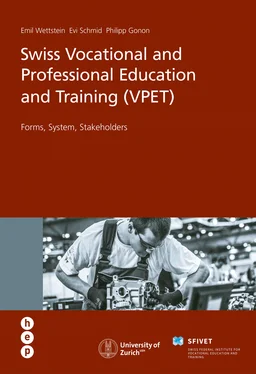
Emil Wettstein, Evi Schmid (SFIVET), Philipp Gonon
Swiss Vocational and Professional Education and Training (VPET)
Forms, System, Stakeholders
ISBN print: 978-3-0355-0863-5
ISBN e-book: 978-3-0355-0908-3
Translated from German by AHA Translation Office and Bostock Translations, edited by Silvia Kübler
First Edition printed in 2017
All rights reserved
© 2017 hep verlag ag, Berne
www.hep-verlag.com
Preface
1 Forms of VPET
1.1 VET in a small company
1.2 VET in a large company
1.3 VET in the cooperative training association
1.4 School-based VET
1.5 VET in a public trade school
1.6 Hybrid forms of VET
1.7 Forms for high-achievers
1.8 Forms for young people with impairments
1.9 Forms characterised by social pedagogy
1.10 Federal PET Diploma and Advanced Federal PET Diploma
1.11 Professional colleges
1.12 Professional education at academic institutions
1.13 VPET outside the responsibility of the Federal Vocational and Professional Education and Training Act
1.14 VET for adults
1.15 Forms of job-related continuing education and training (CET)
1.16 Informal forms of vocational learning
2 VPET – part of the education system and part of the world of work
2.1 Education system
2.2 World of work and labour market
2.3 History of VET in Switzerland (Philipp Gonon)
2.4 Legal foundations
2.5 Governance of VPET
2.6 Funding
3 Elements of successful VPET
3.1 Learning at work
3.2 Simulation
3.3 Reflection
3.4 Action-guiding knowledge
3.5 General education
3.6 Support and assistance
3.7 VPET management
3.8 Certification
4 From school to working life
4.1 Introduction: background and important terms
4.2 Career choice and the search for an apprenticeship position
4.3 The apprenticeship market
4.4 Transitional options and case management
4.5 Termination of an apprenticeship contract, changing apprenticeship position and dropping out from an apprenticeship
4.6 What next after a VET programme?
5 Stakeholders and institutions
5.1 Host companies and cooperative training associations
5.2 VET schools and professional colleges
5.3 The Confederation
5.4 Cantonal authorities
5.5 Professional organisations
5.6 VET professionals
5.7 Stakeholders from research and development
6 Areas of tension
6.1 Academic versus vocational tertiary programmes
6.2 Vocational principle versus modularisation
6.3 Broad versus narrow VET programmes
6.4 Coverage of needs versus shortage of skilled workers
6.5 State versus world of work
6.6 “Bildung” versus qualification
Bibliography
List of Figures
List of Tables
Switzerland offers a unique system of vocational and professional education and training (VPET), which is recognised both locally and internationally and is, on the whole, considered a success. Swiss upper-secondary level vocational education and training (VET) and tertiary-level professional education and training (PET) are part of a well-ordered, high-quality education system. However, the international interdependence on the labour market and, in general, the dynamics of globalisation are putting the sustainability of this model to the test. This challenge, which requires the ability of an entire system to reform and transform itself – while retaining its strengths –, will be a topic in this description of the forms, the system and the stakeholders of Swiss VPET. Yet it is not only international trends which influence VPET in Switzerland, domestic developments do, too – changes in the labour market, the political framework and, in particular, the education system – as well as the trend towards the “knowledge society”. This has an impact on the significance of crafts and trade as the traditional roots of VPET. Technological change tends to promote a shift away from specialisation in favour of an orientation towards more general education and higher education qualifications – which runs counter to an early focus on narrowly confined vocational skills. School-based and tertiary forms of education are in line with such a trend, as are flexibilisation and increasing permeability, which are indeed gaining importance in Switzerland.
As a matter of fact, vocational and professional education and training (VPET) amounts to much more than basic vocational education and training (VET) – in everyday language called “apprenticeship” – in small or medium-sized companies. There are many other variants in addition to this model. All these different forms of VPET are presented in the first chapter of this book. Some will be brought to life by a portrait of a learner or student, written specifically for this book.
The second chapter concerns the framework conditions of VPET. Topics are the integration of VPET in the education system and the labour market, legal foundations, control, the cooperation of partners in VPET as well as funding.
The third chapter deals with particular elements and functions which represent success factors for VPET. This is because apart from training on the job, which is the specific quality of vocational learning, other aspects such as support and guidance and the organisation of the learning process also play a decisive role.
The fourth chapter focuses on VPET as a stage in individual educational pathways between compulsory education (primary and lower-secondary level) and the world of work or tertiary education. We describe the situation of young people in these transition stages and the associated challenges and risks.
In the fifth chapter the major stakeholders of VPET are named. These shape VPET and keep the system running. In this chapter we also present portraits of people who are illustrative examples of the respective stakeholders.
The final chapter focuses on several of the areas of tension which characterise the VPET system today: to what extent can and should the state intervene in VPET? How much should occupations be pooled together or remain separate with their own unique characteristics? What is the connection between education and qualification – are they in a harmonious relationship with each other or do they coexist in conflict?
Many practitioners of VPET but also educational policy makers and academics and above all foreign observers tend to have knowledge of partial areas of the Swiss education system or individual aspects of Swiss VPET. What they frequently lack is an understanding of the interplay among the different elements in the whole system. This book brings together the different facets of VPET and, therefore, provides an overview and helps to create a deeper understanding of the structure and the way the system works as well as the backgrounds.
Swiss Vocational and Professional Education and Training (VPET) serves as a guide and an in-depth overview. The book is aimed at experts and laypeople but also at students dealing with the subject of VPET. This edition is based on the 2014 edition in German. It has also been translated into French and Italian (see box p. 9).
Читать дальше













